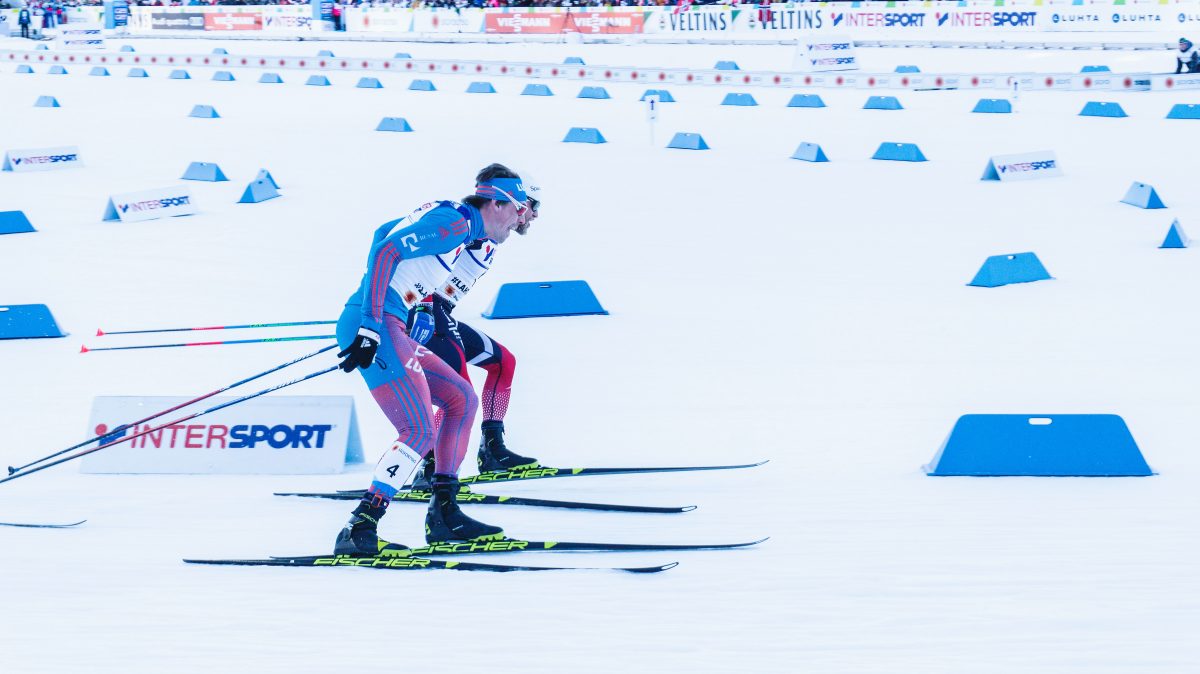If you want to cross-country ski faster, you have to increase the cadence from time to time during training. We show how.
Training for more speed
If you regularly watch cross-country skiing races on television, you sometimes can’t believe your eyes. The best cross-country skiers in the world are already powering along the track at incredible speed, only to increase their cadence and speed again at the third last, second last and above all last ascent before the finish line to such an extent that you think you have accidentally pressed the fast forward button. Classic runners scurry across the slope like sprinters, and skaters fly up the slope with such fast bouncing steps that it is amazing how few crash in the process.
Despite all the frenzy in the final phase of a World Cup race, speed is not as crucial in cross-country skiing as it is in running, as Christian Flury, who is responsible for the National Ski Center in Davos at Swiss Ski, explains: “Cross-country skiers are not sprinters, the take-off times are much longer in cross-country skiing than in running. Accordingly, the pace training of a cross-country skier is different from that of a purebred sprinter in running. For runners, the main thing is to keep the time of contact with the ground as short as possible. In cross-country skiing it is crucial to be able to maintain a first-class quality of movement even at high speed”.
In order to be able to perform a clean technique at maximum speed, top athletes have speed training on roller skis in summer – often interval training with only short sections at maximum speed. Working in the weight room with barbell exercises (knee bends), hurdle jumps or combination forms (lifting heavy weights with few repetitions – immediately followed by cross-country skiing specific movements with a high number of repetitions (e.g. use of arms with elastic band) are also part of the standard program. The corresponding muscles should be enabled to first provide maximum acceleration and then still be able to function even under fatigue.
Increase cadence in the short term
In winter on snow, speed is practiced primarily with techniques that are based on the realities of competition. Attacks with high cadences are usually carried out on slightly uphill terrain. The lower the starting tempo, the stronger the effect of an attack and the less the opponents in the back can benefit from slipstream.
The speed is increased with explosive and short bouncing jumps, supported by an energetic use of arms. Due to the high cadence, the usual shifting of weight is only incomplete. Usually there are only ten or twenty quick steps before the culmination point is reached and then smoothly changes back into a longer step with a greater glide phase.
This is exactly what amateur athletes should practice, so that they can hold a group or close a gap in a cross-country skiing race when they increase their speed. And because the basic speed unfortunately decreases with age, you should work on it from time to time during training. The following two sample trainings show how this can look like:
Hill sprints
(about 80 minutes)
- Easy warm up Skating 10 min
- Constant medium tempo with focus long glide phase and active arm work 15 min.
- Calm tempo with focus on technique and frequent changes of step types 15 min.
- Cadence intervals on a shorter, but not too flat incline In addition, skate loosely about 100 meters on the slope, change cadence explosively at the beginning of the climb and sprint up the slope as fast and energetically as possible.
At the climax at the top of the incline, transition to 1:1 skating stride with focus on body extension, powerful use of arms and glide phase.
Perform about 10 to 15 strides 1:1 at high speed, then stop and recover briefly. Turn around and glide back to the starting point. Recover if necessary. - Repeat the hill sprints about 8 to 10 times. Make sure you have a high tempo and still keep your technique clean.
- Easy cool down 10 minutes.
Tempo and cadence training
(about 70 minutes)
- Easy warm up 10 min.
- Keep a constant pace close to the threshold for about 40 minutes, pace adapted to the terrain.
- With each ascent, short and explosive increase in cadence. For shorter gradients, keep the whole gradient as high as possible up to the culmination point, there transition to 2:1-step with longer glide phase and relaxed pace for 2 to 3 min.
- For longer gradients, increase the cadence to the maximum at the beginning of the gradient for about 20 to 30 seconds, then change to a step that can be held until the end of the gradient. At the culmination point, transition to 2:1 step with a longer glide phase and relaxed tempo for 2 to 3 min. Then transition back to threshold tempo.
- Easy cool down 20 min.
This Blog Article was made available to us by Fit for Life. Fit for Life is the Swiss magazine for fitness, running and endurance sports. Would you like to read such articles regularly? Then Click here.

To create your own personal training plan go to 2PEAK.com
